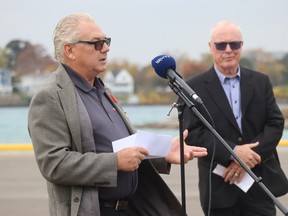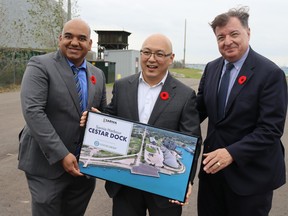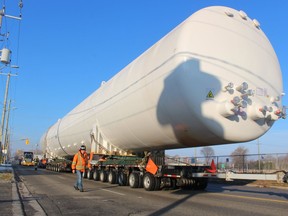
The enlarged and enhanced city dock on the St. Clair River, already has been used by about 20 ships since it began operating in May following an $8.8-million expansion aided with $4 million from Cestar Group, operators of a private college in Toronto that has been a partner of Lambton College for many years.
Rick Perdeaux, a member of the board of the Sarnia-Lambton Industrial Alliance, credited former Lambton College president Judith Morris with making the connection with Cestar when efforts to fund the corridor project had stalled.

The corridor project also received funding from the federal and provincial governments, Lambton County, Sarnia and the industrial society, a group of local businesses serving industry that in 2014 began talking about the idea of a corridor with higher power lines and other accommodations to make it easier to move over-sized loads through the community.
“Even though Cestar College physically exists in Toronto, we feel very attached to the community and the people through the partnership with Lambton College, so we are thrilled to see that this facility will live on in community as a meaningful remainder of the partnership,” Adrian Sharma, Cestar’s chief operator, said in a news release.

Work on the dock that began in 2023 quadrupled its size and made it possible for large components to roll directly on and off barges, Johnson said.

Other parts of the corridor project included burying utility crossings, installing rotating traffic signal bases and other measures to remove barriers on a route through the city and St. Clair Township.
“We can go through an intersection in less than 10 minutes with very minimal traffic disruption” now, Johnson said.
As well as making it easier for large components to be shipped to Sarnia-area refineries, chemical plants and other industries, the corridor aids industrial fabricators in the community which need to move oversized loads to local customers and reach the river to ship to customers further afield.

Before the improvements, those moves could mean arranging for a fleet of utility trucks and other vehicles to accompany a large industrial load travelling slowly through the city, while power lines were raised out of the way.
“We had a load last November go from the Sarnia dock to Plank Road and Kimball in less than 90 minutes,” something that would have taken 10 to 12 hours before the corridor was in place, he said.
“I’m thrilled that it’s completed because it has been a long time in the making,” Perdeaux said. “I know the members from the Sarnia-Lambton Industrial Alliance are 100 per cent behind it.”
The goal now, he added, is to “fill it with lots of outgoing exports to the rest of the countries in the world that need our services.”
Supporters of the corridor project have spoken of its potential to boost local economic activity and create jobs at local industrial fabrication companies.

Perdeaux believes the project was eventually successful “because it benefits everybody” by making travel in the community safer while also changing “the cost dynamic for our fabricators.”

The cost of transporting an oversize load to the harbour previously could range from $150,000 to more than $1 million, he said.
Sarnia Mayor Mike Bradley thanked all those who helped the corridor project come together and said it is a “generational project that will benefit this community for decades.”
